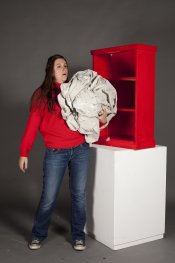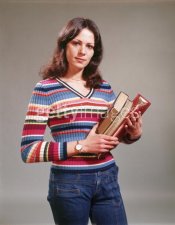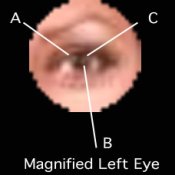Holly,
Regarding the last two images you posted: in the second image, if you look at the area under the subject's right arm, there are two distinct shadows, sharp-edged and of different densities. In the first image, this effect would have shown up where the shadow of her leg falls on the bookcase, but there you have a simple umbra/penumbra with a fairly broad edge. I suspect that this comes from your use of a softbox, where the brightness is pretty even across its width. A lamp in an aluminum reflector acts like a bright, hard light in the center, surrounded by a softer light with a very broad pattern (usually 60-90 degrees, sometimes more). The broad light gives the overall fill that keeps the shadows from going very dark, and the bright lamp in the center creates the multiple shadow lines.
Back then, it was widely understood (correctly or otherwise) that color film did not have the exposure latitude of B/W, so lighting ratios were kept very low by modern standards. Also, may of the "signature" photos were intended for reproduction, where it is easy to compensate for low contrast, but impossible to restore dead shadows or burned-out highlights. It was definitely true that film speeds were typically lower than we are used to today (High Speed Ektachrome, tungsten balanced was all of 125 ASA), so there was a strong tendency to keep the lights in fairly close and this also meant that there wasn't likely to be a large lighting ratio.
If you are good with a light meter and not too concerned with color fidelity, you can combine flash and continuous light---it would be best to light the background with a flood if you only have two working flashes, to preserve the multiple shadow edges that make up so much of "that 70s look".
If your softboxes have removable front diffusers, you might try lighting the picture with bare bulbs surrounded by the softbox shells. I tried this once, and was surprised at how much the lighting resembled the old Smith-Victor reflectors.
Finally, if your intent is to place something modern into a characteristically 70s picture, you will have to either exaggerate the image characteristics or reduce the initial impact of the modern elements (or both). The young ladies in the vintage examples have hair, clothing, and posture that is faithful to the era; make these modern, and I suspect that most viewers will have a hard time reading the picture as anything but a recent creation. If you can locate the book The Psychology of Everyday Things, by Donald Norman, you will find a very readable discussion of why human perception works this way.





